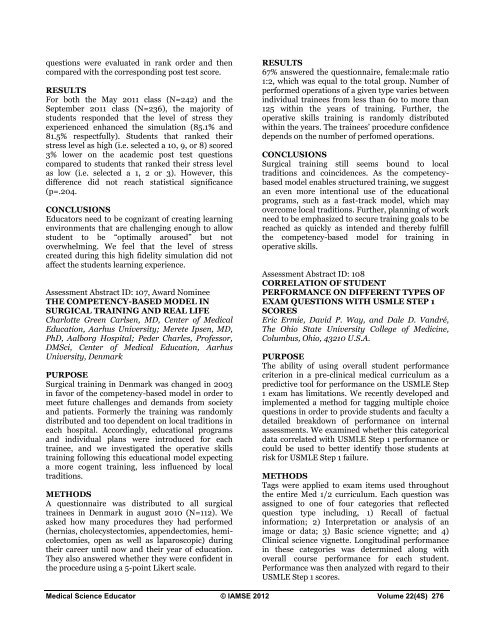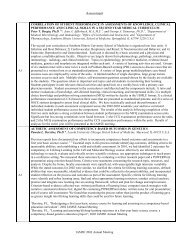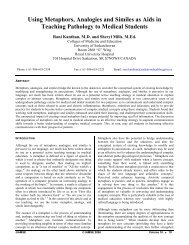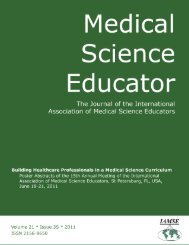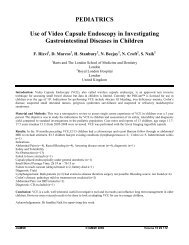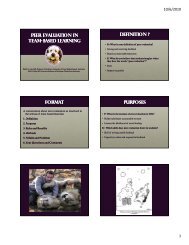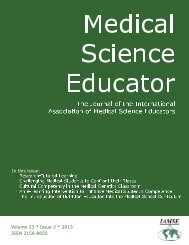Click here to view complete journal in pdf-format - IAMSE
Click here to view complete journal in pdf-format - IAMSE
Click here to view complete journal in pdf-format - IAMSE
You also want an ePaper? Increase the reach of your titles
YUMPU automatically turns print PDFs into web optimized ePapers that Google loves.
questions were evaluated <strong>in</strong> rank order and then<br />
compared with the correspond<strong>in</strong>g post test score.<br />
RESULTS<br />
For both the May 2011 class (N=242) and the<br />
September 2011 class (N=236), the majority of<br />
students responded that the level of stress they<br />
experienced enhanced the simulation (85.1% and<br />
81.5% respectfully). Students that ranked their<br />
stress level as high (i.e. selected a 10, 9, or 8) scored<br />
3% lower on the academic post test questions<br />
compared <strong>to</strong> students that ranked their stress level<br />
as low (i.e. selected a 1, 2 or 3). However, this<br />
difference did not reach statistical significance<br />
(p=.204.<br />
CONCLUSIONS<br />
Educa<strong>to</strong>rs need <strong>to</strong> be cognizant of creat<strong>in</strong>g learn<strong>in</strong>g<br />
environments that are challeng<strong>in</strong>g enough <strong>to</strong> allow<br />
student <strong>to</strong> be “optimally aroused” but not<br />
overwhelm<strong>in</strong>g. We feel that the level of stress<br />
created dur<strong>in</strong>g this high fidelity simulation did not<br />
affect the students learn<strong>in</strong>g experience.<br />
Assessment Abstract ID: 107, Award Nom<strong>in</strong>ee<br />
THE COMPETENCY-BASED MODEL IN<br />
SURGICAL TRAINING AND REAL LIFE<br />
Charlotte Green Carlsen, MD, Center of Medical<br />
Education, Aarhus University; Merete Ipsen, MD,<br />
PhD, Aalborg Hospital; Peder Charles, Professor,<br />
DMSci, Center of Medical Education, Aarhus<br />
University, Denmark<br />
PURPOSE<br />
Surgical tra<strong>in</strong><strong>in</strong>g <strong>in</strong> Denmark was changed <strong>in</strong> 2003<br />
<strong>in</strong> favor of the competency-based model <strong>in</strong> order <strong>to</strong><br />
meet future challenges and demands from society<br />
and patients. Formerly the tra<strong>in</strong><strong>in</strong>g was randomly<br />
distributed and <strong>to</strong>o dependent on local traditions <strong>in</strong><br />
each hospital. Accord<strong>in</strong>gly, educational programs<br />
and <strong>in</strong>dividual plans were <strong>in</strong>troduced for each<br />
tra<strong>in</strong>ee, and we <strong>in</strong>vestigated the operative skills<br />
tra<strong>in</strong><strong>in</strong>g follow<strong>in</strong>g this educational model expect<strong>in</strong>g<br />
a more cogent tra<strong>in</strong><strong>in</strong>g, less <strong>in</strong>fluenced by local<br />
traditions.<br />
METHODS<br />
A questionnaire was distributed <strong>to</strong> all surgical<br />
tra<strong>in</strong>ees <strong>in</strong> Denmark <strong>in</strong> august 2010 (N=112). We<br />
asked how many procedures they had performed<br />
(hernias, cholecystec<strong>to</strong>mies, appendec<strong>to</strong>mies, hemicolec<strong>to</strong>mies,<br />
open as well as laparoscopic) dur<strong>in</strong>g<br />
their career until now and their year of education.<br />
They also answered whether they were confident <strong>in</strong><br />
the procedure us<strong>in</strong>g a 5-po<strong>in</strong>t Likert scale.<br />
RESULTS<br />
67% answered the questionnaire, female:male ratio<br />
1:2, which was equal <strong>to</strong> the <strong>to</strong>tal group. Number of<br />
performed operations of a given type varies between<br />
<strong>in</strong>dividual tra<strong>in</strong>ees from less than 60 <strong>to</strong> more than<br />
125 with<strong>in</strong> the years of tra<strong>in</strong><strong>in</strong>g. Further, the<br />
operative skills tra<strong>in</strong><strong>in</strong>g is randomly distributed<br />
with<strong>in</strong> the years. The tra<strong>in</strong>ees’ procedure confidence<br />
depends on the number of perfomed operations.<br />
CONCLUSIONS<br />
Surgical tra<strong>in</strong><strong>in</strong>g still seems bound <strong>to</strong> local<br />
traditions and co<strong>in</strong>cidences. As the competencybased<br />
model enables structured tra<strong>in</strong><strong>in</strong>g, we suggest<br />
an even more <strong>in</strong>tentional use of the educational<br />
programs, such as a fast-track model, which may<br />
overcome local traditions. Further, plann<strong>in</strong>g of work<br />
need <strong>to</strong> be emphasized <strong>to</strong> secure tra<strong>in</strong><strong>in</strong>g goals <strong>to</strong> be<br />
reached as quickly as <strong>in</strong>tended and t<strong>here</strong>by fulfill<br />
the competency-based model for tra<strong>in</strong><strong>in</strong>g <strong>in</strong><br />
operative skills.<br />
Assessment Abstract ID: 108<br />
CORRELATION OF STUDENT<br />
PERFORMANCE ON DIFFERENT TYPES OF<br />
EXAM QUESTIONS WITH USMLE STEP 1<br />
SCORES<br />
Eric Ermie, David P. Way, and Dale D. Vandré,<br />
The Ohio State University College of Medic<strong>in</strong>e,<br />
Columbus, Ohio, 43210 U.S.A.<br />
PURPOSE<br />
The ability of us<strong>in</strong>g overall student performance<br />
criterion <strong>in</strong> a pre-cl<strong>in</strong>ical medical curriculum as a<br />
predictive <strong>to</strong>ol for performance on the USMLE Step<br />
1 exam has limitations. We recently developed and<br />
implemented a method for tagg<strong>in</strong>g multiple choice<br />
questions <strong>in</strong> order <strong>to</strong> provide students and faculty a<br />
detailed breakdown of performance on <strong>in</strong>ternal<br />
assessments. We exam<strong>in</strong>ed whether this categorical<br />
data correlated with USMLE Step 1 performance or<br />
could be used <strong>to</strong> better identify those students at<br />
risk for USMLE Step 1 failure.<br />
METHODS<br />
Tags were applied <strong>to</strong> exam items used throughout<br />
the entire Med 1/2 curriculum. Each question was<br />
assigned <strong>to</strong> one of four categories that reflected<br />
question type <strong>in</strong>clud<strong>in</strong>g, 1) Recall of factual<br />
<strong>in</strong><strong>format</strong>ion; 2) Interpretation or analysis of an<br />
image or data; 3) Basic science vignette; and 4)<br />
Cl<strong>in</strong>ical science vignette. Longitud<strong>in</strong>al performance<br />
<strong>in</strong> these categories was determ<strong>in</strong>ed along with<br />
overall course performance for each student.<br />
Performance was then analyzed with regard <strong>to</strong> their<br />
USMLE Step 1 scores.<br />
Medical Science Educa<strong>to</strong>r © <strong>IAMSE</strong> 2012 Volume 22(4S) 276


